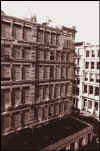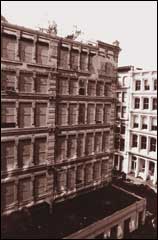 |
New York
Architecture Images-Soho 112 Prince Street. |
|
architect |
Richard Berger |
|
location |
112 Prince Street |
|
date |
1889 |
|
style |
neo–Grec Renaissance Revival |
|
construction |
Cast Iron Facade |
|
type |
Shop Office Warehouse |
|
|
|
|
images |
 |
|
|
|
|
notes |
112 PRINCE STREET and it's TROMPE L'OEIL MURAL 112 Prince Street was constructed in 1889 by Richard Berger, also known for several other buildings in SoHo. Architect Berger employed the stylish neo–Grec mode for this six–story iron front building. The stories are nearly identical but they diminish in height so that the slender collonettes on the ground floor are considerably taller than those on the top. These collonettes, with stylized capitals, stand on pedestals and support impost blocks topped by cast iron rosettes. Each level is marked by an entablature, terminated at each end by a decorative block, supported by paired consoles. A central raised pediment embracing a sunburst design, ornaments the roof cornice. Over the years, this practical warehouse had a variety of tenants, among them, fabric concerns, and later, a toy factory. By 1975, the upper floors had become work/live lofts for artists. Maya Lin, the noted sculptor of the Viet Nam memorial in Washington, D. C., now lives in this building. In the early 1970s, the famous artist Richard Haas and a friend proposed using the building’s crude brick east wall as a “canvas” for a trompe l’oeil mural imitating the design of the building’s iron facade. Haas completed the mural in April 1975 with a grant from the National Endowment of the Arts. Since June of 1993, the ground floor has been home to the Mimi Ferzt Gallery, specializing in non–conformist Russian contemporary art. The work of a St. Petersburg artist, a 16 foot bronze statue, Cybelle, the goddess of fertility, stands on the sidewalk outside the gallery. After the cast iron facade was struck by lightning in late 1998, a sidewalk scaffold was erected, that still obscures the distinguished facade of 112 Prince Street. |
|
links |